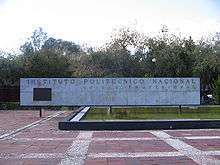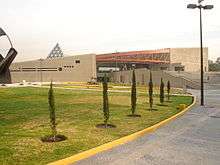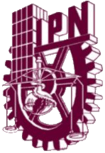Instituto Politécnico Nacional
| Instituto Politécnico Nacional | |
|
Official Seal | |
| Motto | La Técnica al Servicio de la Patria[1] |
|---|---|
Motto in English | Technology to meet the needs of the Nation[2] |
| Type | Public |
| Established | 1 January 1936[3] |
| Dean | Jesús Ávila Galinzoga[4] |
| Director | Enrique Fernández Fassnacht[4][5] |
Academic staff | 17,534[6] |
Administrative staff | 10,383[6] |
| Students | 171,581[6] |
| Undergraduates | 100,854[6] |
| Postgraduates | 6,836[6] |
Other students | 63,891 (High school)[6] |
| Location |
Mexico City, 19°30′02″N 99°08′23″W / 19.50056°N 99.13972°WCoordinates: 19°30′02″N 99°08′23″W / 19.50056°N 99.13972°W |
| Campus | Several across Mexico, mostly urban[7] |
| Colors | Maroon and white |
| Athletics |
Burros Blancos (White Donkeys) Águilas Blancas (White Eagles) ONEFA Central Conference[8][9] |
| Sports | 27 varsity teams[10] |
| Nickname | Burros Blancos |
| Mascot | White donkey[11] |
| Affiliations | AMECYD,[12] ANUIES,[13] AUIP,[14] CLARA,[15] COMEPO,[16] CUDI,[17] ECOES,[18] OUI,[19] UDUAL,[20] Universia[21] |
| Website | www.ipn.mx |
| Staff, students and organization data is for 2013.[6] High school students account for the difference between its total number of students and the sum of undergraduate and postgraduate students. | |
The Instituto Politécnico Nacional (Spanish for National Polytechnic Institute) (IPN) is one of the largest public universities in Mexico with 171,581 students[6] at the high school, undergraduate and postgraduate levels. It was founded on 1 January 1936 during the administration of President Lázaro Cárdenas del Río as a response to provide professional education to the most disadvantaged social classes in that period, a practice that is maintained because it is one of the few vocational schools in the world.[22]
The institute consists of 98 academic units offering 293 courses of study.[6] It includes 78 technical careers, 80 undergraduate and 135 postgraduate programs.[6] Its main campus, called 'Unidad Profesional Adolfo López Mateos' or 'Zacatenco', is on approximately 530 acres (2.1 km2) north Mexico City.[7]
The IPN is based primarily in Mexico City and its suburbs, but with several research institutes and facilities distributed over 22 states.[6]
History

The institute was founded on January 1, 1936 during the administration of President Lázaro Cárdenas in what had been previously known as the Ex hacienda Santo Tomás — a large estate initially owned by Spanish conquistador Hernán Cortés in the 16th century[22] and donated by the federal government.[23]
Prominent astronomer Luis Enrique Erro, former revolutionary Juan de Dios Bátiz Paredes and former minister of education Narciso Bassols were among its initial promoters.[23]
During the administration of former director Alejo Peralta sufficient lands were given to IPN. Expropriated lands of Santa Maria Ticomán (213 ha) and San Pedro Zacatenco (43 ha) were used.[7]
The construction of what is now the Professional Unit "Adolfo López Mateos" (Zacatenco) began in 1958. In 1959, former President Adolfo López Mateos, the former minister of education Jaime Torres Bodet, and former director of IPN Eugenio Mendez Docurro, inaugurated the first four buildings of Zacatenco, which were occupied by the Superior School of Mechanical and Electrical Engineering (ESIME) and the Superior School of Engineering and Architecture (ESIA).[7]
Organization
The institute is organized around 98 academic units[6] including 18 vocational high schools (operates as CECyT), 26 university colleges, 20 scientific and technical research centers, 17 continuing education centers, 4 units for educational support, 3 support units for education innovation, 8 support units for research, development and technological and enterprise foment, and 2 units affiliated to science, enterprise research and development.
These schools are primarily in Mexico City, although several extension and research facilities are distributed over 22 states.[6]
Some units (particularly the semi-autonomous, internationally renowned CINVESTAV) enjoy a high degree of academic and budgetary freedom. The institute as a whole is headed by a director-general appointed by the President of Mexico, usually (but not always) after some consultation with members of its academic community.[24] Since November 2014, its director-general is Enrique Fernández Fassnacht.[5]
In addition to its academic endeavors, and as part of its cultural promotion strategy, the institute operates 'Canal Once', the oldest public broadcast service in Latin America[25] featuring original cultural, scientific, information and entertainment programming, foreign shows and classic, rare, and non-commercial films from all over the world.
Academics

The Institute offers 80 undergraduate programs[6] leading to four- or five-year bachelor's degrees and 135 postgraduate programs[6] leading to 29 postgraduate diplomas,[6] 70 master's degrees[6] and 36 doctorate degrees.[6]
Like most public universities in Mexico, in addition to its undergraduate and graduate schools the institute sponsors several vocational high schools called 'Centros de Estudios Científicos y Tecnológicos' (C.E.C. y T.), most of which are in Greater Mexico City. Upon completion, they lead to a technician degree. For this level of study, the institute offers 78 technical careers.[6]
Athletics
IPN fields 27 varsity teams in sports or activities such as archery, American football, athletics, baseball, basketball, body building, bowling, boxing, chess, cycling, frontenis, gymnastics, handball, indoor soccer, judo, karate, kendo, mountaineering, rowing, soccer, swimming, taekwondo, tennis, touch football, volleyball, weightlifting and wrestling.[10]
The university maintains a fierce rivalry with all the athletic teams from the National Autonomous University of Mexico but have a particularly bitter competition with its football program, the "Pumas Dorados" (Golden Pumas).
Notable people
Notable alumni
Scientists and technologists
- Guillermo González Camarena: television pioneer; inventor of an early color television transmission system.
- Jerzy Rzedowski: plant scientist; pioneer of Neotropical floristics.
- Esther Orozco: biology researcher, winner of the 1997 UNESCO/Institut Pasteur Medal and the 2006 L'Oréal-UNESCO Awards for Women in Science for her work on amoebiasis.
- Evangelina Villegas: biochemist laureated with the 2000 World Food Prize and whose work with maize led to the development of Quality Protein Maize (QPM).
- Pablo Rudomín: neuroscientist laureated with the Prince of Asturias Award (1987).
- Gilberto Calvillo Vives: president of the United Nations' Statistics Commission.
- Alberto Pérez Gómez: architectural historian and winner of the 1984 Alice Davis Hitchcock Award.
- Ruth Rivera Marin: architect, the first woman to study architecture at the College of Engineering and Architecture
- Constantino Reyes-Valerio: chemist and art historian, discovered the recipe to create Maya blue and coined the term Arte Indocristiano
- Raúl Rojas: professor of Computer Science and Mathematics and a renowned specialist in artificial neural networks.
Politicians
- Ernesto Zedillo: former President of Mexico (1994-2000).
- Josefina Vázquez Mota: former Secretary of Education (Mexico).
- Reyes Tamez: Secretary of Education during the Fox administration.
- Victor Bravo Ahuja: Secretary of Education during the Echeverría admninistration.
- Walter Cross Buchanan: Secretary of Communications and Transportation during the López Mateos administration
- José Antonio Padilla Segura: Secretary of Communications and Transportation during the Díaz Ordaz administration
- Eugenio Méndez Docurro: Secretary of Communications and Transportation during the Echeverría administration
- Héctor Mayagoitia Domínguez: former Governor of Durango (1974-1979).
- Miguel Borge Martín: former Governor of Quintana Roo (1987-1993).
- Roberto Kobeh González: ICAO Council President (2006-2014)
Notable faculty
- See also Category: Instituto Politécnico Nacional faculty
- Alexander Balankin: scientist, winner of the 2005 UNESCO Science Prize for his works on fractal mechanics.
- Heberto Castillo: inventor of tridilosa and founder of several political parties.
- Juan O'Gorman: architect and painter.
- Arturo Rosenblueth: physician, physiologist, and noted researcher.
See also
- National Polytechnic Institute College of Engineering and Physical-Mathematic Sciences
- National Polytechnic Institute College of Biomedical Sciences
- National Polytechnic Institute College of Social and Administrative Sciences
- National Polytechnic Institute College of Interdisciplinary Studies
References
- ↑ National Polytechnic Institute. "Lema" (in Spanish). Retrieved October 6, 2009.
- ↑ National Polytechnic Institute. "About Us". Retrieved January 5, 2014.
- ↑ National Polytechnic Institute. "Compendio histórico 1930-1939" (in Spanish). Retrieved October 6, 2009.
- 1 2 National Polytechnic Institute. "Directorio de Servidores Públicos de Mando y Dirección" (PDF) (in Spanish). Retrieved December 16, 2014.
- 1 2 Quadratin México. "Designan a Enrique Fernández Fassnacht director del IPN" (in Spanish). Retrieved December 16, 2014.
- 1 2 3 4 5 6 7 8 9 10 11 12 13 14 15 16 17 18 19 National Polytechnic Institute. "Informe Anuel de Actividades dos mil trece" (PDF) (in Spanish). Retrieved December 16, 2014.
- 1 2 3 4 Universia Mexico (March 20, 2009). "Conmemora IPN 50 aniversario de la unidad "Adolfo López Mateos"" (in Spanish). Retrieved October 6, 2009.
- ↑ Vanguardia. "Se divide la ONEFA; Nacen la Conferencia del Centro y la Conferencia de los Seis Grandes" (in Spanish). Retrieved December 9, 2009.
- ↑ esmas.com. "Se divide la ONEFA, con la creación de la Conferencia del Centro" (in Spanish). Retrieved December 9, 2009.
- 1 2 National Polytechnic Institute. "Disciplinas" (in Spanish). Retrieved April 22, 2010.
- ↑ National Polytechnic Institute. "Mascota" (in Spanish). Archived from the original on April 12, 2009. Retrieved October 6, 2009.
- ↑ Asociación Mexicana de Educación Continua y a Distancia A.C. (AMECYD). "Instituciones Afiliadas" (in Spanish). Retrieved December 9, 2009.
- ↑ Asociación Nacional de Universidades e Instituciones de Eduación Superior (ANUIES). "Instituciones Afiliadas, Distrito Federal" (in Spanish). Retrieved December 9, 2009.
- ↑ Asociación Universitaria Iberoamericana de Postgrado (AUIP). "Asociadas a la AUIP" (in Spanish). Retrieved December 9, 2009.
- ↑ Cooperación Latinoamericana de Redes Avanzadas (CLARA). "Miembros México" (in Spanish). Retrieved December 9, 2009.
- ↑ Consejo Mexicano de Estudios de Posgrado A.C. (COMEPO). "COMEPO - Miembros Afiliados" (in Spanish). Retrieved December 9, 2009.
- ↑ Corporación Universitaria para el Desarrollo de Internet A.C. (CUDI). "Membresía CUDI. Universidades, Centros e Instituciones de Investigación" (PDF) (in Spanish). Retrieved December 9, 2009.
- ↑ Espacio Común de Educación Superior (ECOES). "Instituciones Participantes" (in Spanish). Retrieved March 14, 2010.
- ↑ Organización Universitaria Interamericana (OUI). "Miembros" (in Spanish). Retrieved December 9, 2009.
- ↑ Unión de Universidades de América Latina (UDUAL). "Directorio de Instituciones Afiliadas a la UDUAL" (in Spanish). Retrieved December 9, 2009.
- ↑ Universia Mexico. "Instituto Politécnico Nacional" (in Spanish). Retrieved December 9, 2009.
- 1 2 National Polytechnic Institute. "Antecedentes del Centro Histórico y Cultural "Juan de Dios Bátiz"" (in Spanish). Retrieved December 9, 2009.
- 1 2 National Polytechnic Institute. "Historia" (in Spanish). Archived from the original on November 23, 2007. Retrieved November 25, 2007.
- ↑ La Jornada. "Villa Rivera: nombrar director del IPN, facultad sólo del Presidente" (in Spanish). Retrieved November 25, 2007.
- ↑ Canal Once. "Acerca de Canal Once" (in Spanish). Retrieved December 21, 2147. Check date values in:
|access-date=(help)
External links
| Wikimedia Commons has media related to Instituto Politécnico Nacional. |
- (Spanish) Official website
